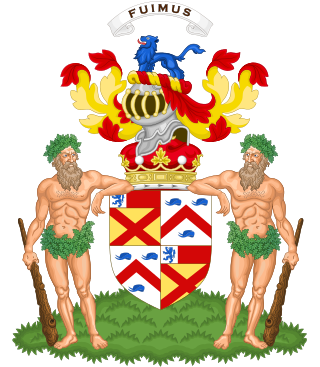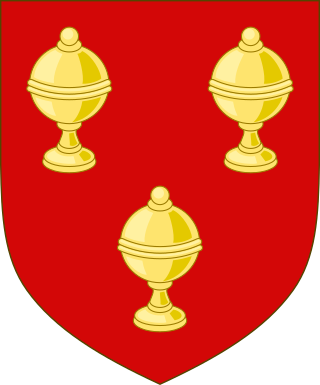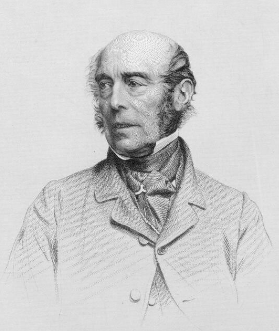
A marquess is a nobleman of high hereditary rank in various European peerages and in those of some of their former colonies. The German-language equivalent is Markgraf (margrave). A woman with the rank of a marquess or the wife of a marquess is a marchioness or marquise. These titles are also used to translate equivalent Asian styles, as in Imperial China and Imperial Japan.
The Peerage of Ireland consists of those titles of nobility created by the English monarchs in their capacity as Lord or King of Ireland, or later by monarchs of the United Kingdom of Great Britain and Ireland. It is one of the five divisions of Peerages in the United Kingdom. The creation of such titles came to an end in the 19th century. The ranks of the Irish peerage are duke, marquess, earl, viscount and baron. As of 2016, there were 135 titles in the Peerage of Ireland extant: two dukedoms, ten marquessates, 43 earldoms, 28 viscountcies, and 52 baronies. However, these titles have no official recognition in the Republic of Ireland, with Article 40.2 of the Constitution of Ireland forbidding the state conferring titles of nobility and stating that an Irish citizen may not accept titles of nobility or honour except with the prior approval of the Irish government.

Duke of Wellington is a title in the Peerage of the United Kingdom. The name derived from Wellington in Somerset. The title was created in 1814 for Arthur Wellesley, 1st Marquess of Wellington, the Anglo-Irish military commander who is best known for leading the decisive victory with Field Marshal von Blücher over Napoleon's forces at Waterloo in Brabant. Wellesley later served twice as British prime minister. In historical texts, unqualified use of the title typically refers to the 1st Duke.

The titles of Earl of Hertford and Marquess of Hertford have been created several times in the peerages of England and Great Britain.

Marquess of Waterford is a title in the Peerage of Ireland and the premier marquessate in that peerage. It was created in 1789 for the Anglo-Irish politician George Beresford, 2nd Earl of Tyrone. The title is presently held by Henry Beresford, 9th Marquess of Waterford.

Marquess of Headfort is a title in the Peerage of Ireland. It was created in 1800 for Thomas Taylour, 2nd Earl of Bective.

Marquess of Londonderry, of the County of Londonderry, is a title in the Peerage of Ireland.

Marquess of Ailesbury, in the County of Buckingham, is a title in the Peerage of the United Kingdom. It was created on 17 July 1821 for Charles Brudenell-Bruce, 2nd Earl of Ailesbury.

Earl of Antrim is a title that has been created twice, both times in the Peerage of Ireland and both times for members of the MacDonnell family, originally of Scottish origins.

Marquess of Cambridge was a title that was created twice, once in the Peerage of England and once in the Peerage of the United Kingdom.

Duke of Leeds was a title in the Peerage of England. It was created in 1694 for the prominent statesman Thomas Osborne, 1st Marquess of Carmarthen, who had been one of the Immortal Seven in the Revolution of 1688. He had already succeeded as 2nd Baronet, of Kiveton (1647) and been created Viscount Osborne, of Dunblane (1673), Baron Osborne, of Kiveton in the County of York and Viscount Latimer, of Danby in the County of York, Earl of Danby, in the County of York (1674), and Marquess of Carmarthen (1689). All these titles were in the Peerage of England, except for the viscountcy of Osborne, which was in the Peerage of Scotland. He resigned the latter title in favour of his son in 1673. The Earldom of Danby was a revival of the title held by his great-uncle, Henry Danvers, 1st Earl of Danby.

The peerage title Earl of Ormond and the related titles Duke of Ormonde and Marquess of Ormonde have a long and complex history. An earldom of Ormond has been created three times in the Peerage of Ireland.

Marquess of Willingdon was a title in the Peerage of the United Kingdom. It was created on 26 May 1936 for the Liberal politician and colonial governor Freeman Freeman-Thomas, 1st Earl of Willingdon. He was Governor-General of Canada from 1926 to 1931 and Viceroy of India from 1931 to 1936.

David George Philip Cholmondeley, 7th Marquess of Cholmondeley,, styled Viscount Malpas from birth until 1968, and subsequently Earl of Rocksavage until 1990, is a British peer and filmmaker who acted as Lord Great Chamberlain of the United Kingdom from 1990 to 2022.

Frederick William Robert Stewart, 4th Marquess of Londonderry, styled Viscount Castlereagh from 1822 to 1854, was a British nobleman and Tory politician. He was briefly Vice-Chamberlain of the Household under Sir Robert Peel between December 1834 and April 1835.

Ulick John de Burgh, 1st Marquess of Clanricarde, styled Lord Dunkellin until 1808 and the Earl of Clanricarde from 1808 until 1825, was a British Whig politician who served as British Ambassador to Russia (1838–40), Postmaster General (1846–52) and Lord Keeper of the Privy Seal (1858).











